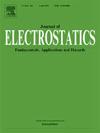基于CFD的金属气溶胶静电收集数值模拟
IF 2.1
4区 工程技术
Q3 ENGINEERING, ELECTRICAL & ELECTRONIC
引用次数: 0
摘要
为了解决气溶胶颗粒收集效率低的问题,利用COMSOL Multiphysics仿真分析软件建立了气溶胶颗粒收集模型并提出了相应的优化策略。本研究采用COMSOL Multiphysics软件中的有限元方法模拟了不同氡子金属气溶胶粒径对流场和电场的影响。金属气溶胶是用流体流动和电场相结合的方法产生的。该模型通过选择适宜的收集室内电场流速(10.0 ~ 400.0 mm/s)和电压(5.0 kV)来优化收集,从而增强颗粒聚集。微粒经电子针进一步带电后,在阴极极板上聚集,随着流速的增大,收集效率在中间增强,在边缘减弱,对粒径较小的微粒更有效。模拟结果描述了不同粒径气溶胶粒子的流场和电场分布。将该方法与气溶胶模拟相结合,提出了一种提高金属粉末静电收集效率的新策略。本文章由计算机程序翻译,如有差异,请以英文原文为准。
Numerical simulation of metal aerosol electrostatic collection based on CFD
In order to solve the problem of low collection efficiency of aerosol particles, a model and corresponding optimization strategy were constructed by using COMSOL Multiphysics simulation and analysis. In this study, the finite element method in COMSOL Multiphysics was used to simulate the impact of various radon progeny metal aerosol particle sizes on the flow and electric fields. The metal aerosol was generated using a method that combines fluid flow and electric fields for collection. The model optimizes collection by selecting the right flow velocity (10.0–400.0 mm/s) and voltage (5.0 kV) for the electric field in the collection chamber, which enhances particle aggregation. After the particles are further charged using an electroneedle, they accumulate on the cathode plate, as the flow velocity increases, the collection efficiency is enhanced in the middle and diminishes at the edges, and it is more effective for smaller particle sizes. The simulation results depict the flow and electric field distributions of aerosol particles with varying sizes. By integrating this approach with aerosol simulations, a new strategy to enhance the electrostatic collection efficiency of metal powder is developed.
求助全文
通过发布文献求助,成功后即可免费获取论文全文。
去求助
来源期刊

Journal of Electrostatics
工程技术-工程:电子与电气
CiteScore
4.00
自引率
11.10%
发文量
81
审稿时长
49 days
期刊介绍:
The Journal of Electrostatics is the leading forum for publishing research findings that advance knowledge in the field of electrostatics. We invite submissions in the following areas:
Electrostatic charge separation processes.
Electrostatic manipulation of particles, droplets, and biological cells.
Electrostatically driven or controlled fluid flow.
Electrostatics in the gas phase.
 求助内容:
求助内容: 应助结果提醒方式:
应助结果提醒方式:


